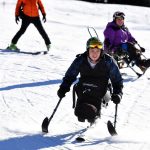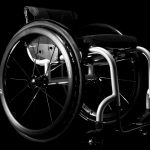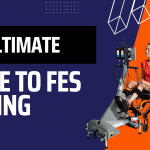RT300 for spinal cord injury rehabilitation
Medtech innovation briefing
Published: 16 January 2019
Summary
The technology described in this briefing is RT300, a functional electrical stimulation (FES) integrated cycling system. It is used to start muscle contraction to stimulate trunk and limb muscles in people with spinal cord injury.
The innovative aspect is that the RT300 combines FES with a cycle ergometer, allowing stimulation of muscles in the trunk and arms or legs during a cycling motion as part of rehabilitation or physical activity for people with spinal cord injury. The combined motor and electrical stimulation system adjusts resistance and speed to make sure stimulation is safe for optimal treatment. The system links to a database to store and monitor performance data.
The intended place in therapy would be as well as standard rehabilitation care for people with spinal cord injuries. This would start in specialist spinal injuries units but can be given in any setting.
The main points from the evidence summarised in this briefing are from 6 studies (3 randomised trials and 3 observational studies), including a total of 103 patients (43 adults and 60 children) in the US and Canada. Limited evidence shows that using RT300 may be associated with an improvement in quality of life and an increase in muscle volume compared with passive cycling systems or pre-treatment baseline.
Key uncertainties around the evidence or technology are that the study results may not be generalisable to the NHS. The studies were small and the comparative studies used a passive cycling system from the same manufacturer.
The cost of RT300 ranges from £18,995 to £24,995 per unit with 6-channel stimulations (exclusive of VAT) plus an annual service charge of £495. An extra 6-channel stimulation unit costs £8,995. The resource impact is unclear because of a lack of evidence and uncertainty in the standard care pathway and which people may benefit.
The technology
The RT300 combines functional electrical stimulation (FES) with a motorised ergometer that allows repetitive cycling activity as part of a rehabilitation programme for people with a spinal cord injury.
It stimulates muscles with electrodes attached to the skin, producing muscle contractions and patterned activity. It can stimulate muscle groups in 1 or both arms or legs and trunk in a coordinated cycling motion. The standard configuration stimulates 6 muscle groups with 1 stimulator. Another 6 muscle groups can be stimulated by an extra stimulator and 4 more can be stimulated by individual Bluetooth stimulators. Training plans vary in clinical practice. The typical training session can range from 15 to 60 minutes per session, 3 to 4 times per week. The training can last from 6 weeks up to lifetime use depending on the severity of spinal injuries.
RT300 has systems configurable for different muscle groups (arms, legs) and can be used while in a wheelchair, chair or bed. It can be used by children.
During a therapy session, the technology starts by passively cycling muscles and prepares them for exercise. Electrical stimulation then gradually activates the muscles to work up to a target speed or until muscle fatigue is detected. Different parameters can be changed depending on the person’s progress, such as current amplitude and frequency, pulse width and resistance. The RT300 has an automatic setting which adjusts the ergometer resistance or the stimulation to safely get to the target speed and avoid excessive muscle movement. RT300 will stop if it detects too much muscle spasm to avoid injury. All functions of the RT300 are controlled by a tablet computer.
Innovations
The RT300 system has a motor built into the stimulation system to automatically adjust the stimulation and the ergometer resistance. This is not available in other FES systems. The company claims this allows therapy to respond to individual patient performance, to maximise muscle contractions and to give consistent and reliable outcomes.
RT300 systems use software that sends data through a secure Wi-Fi connection from the tablet computer to a cloud-based database. This means data can be monitored by therapists and therapy can be customised. Data collected in treatment sessions can be exported as documents in formats such as Excel and PDF, which can be included in individuals’ NHS electronic records.
Current NHS pathway
NICE’s guideline on spinal injury covers early management in pre-hospital settings (including ambulance services), emergency departments and major trauma centres but does not cover rehabilitation. The British Society of Rehabilitation Medicine guideline on chronic spinal cord injury also does not include rehabilitation.
NICE’s interventional procedures guidance on functional electrical stimulation for drop foot of central neurological origin supports the use of FES for drop foots from conditions such as stroke, cerebral palsy, multiple sclerosis or spinal cord injury provided that normal arrangements are in place for clinical governance, consent and audit.
The current standard care after a spinal cord injury involves acute care after the injury, rehabilitation and reintegration into the community, lifelong follow-up of people living with spinal cord injury, and further admission if necessary for medical or surgical management (NHS England 2013). Rehabilitation following spinal cord injury starts as soon as the patient is medically stable after injury, and focuses on increasing functional independence (Harvey 2016). A range of rehabilitation measures can be used to improve function or compensate for loss of function, such as exercise (WHO 2013).
NICE is aware of the following CE-marked FES-assisted cycling systems that appear to fulfil a similar function to RT300:
- Rehamove: FES cycling system for weakened or paralysed arms or legs
- BerkelBike: FES-assisted outdoor leg cycling
Population, setting and intended user
RT300 would be used in a rehabilitation setting with standard rehabilitation care for adults or children with weakened or paralysed muscles in their arms or legs because of spinal cord injury. The technology can also be used in the home.
A trained therapist would set up the RT300 system after a complete assessment of the patient. The therapy could then be given by a therapy assistant or carer at home. Physiotherapists would need training to use RT300.
Costs
Technology costs
Table 1 Cost of RT300
| Description | Cost1 |
| RT300 leg cycle (6 channels) | £18,995 (ex VAT) |
| RT300 leg and arm cycle (6 channels) | £24,995 (ex VAT) |
| Additional 6 channels | £8,995 (ex VAT) |
| Delivery, installation and clinical follow-up | £495 (ex VAT) |
| RT300 service charge | £495 annually |
| Electrodes2 | £528 annually |
- The technology has an 8 year lifespan. The cost may vary depending on the number of channels available.
- The cost is based on a single patient using the RT300 3 times per week for 1 year.
Costs of standard care
No estimate for the complete cost of rehabilitation care for people with spinal cord injuries could be identified. One expert noted the cost of other passive FES equipment varied from £50 to £3,500. The number of rehabilitation (physiotherapy) sessions during which treatment with RT300 would be used varies between patients. The estimated cost of a hospital physiotherapist is £60 per hour.
Resource consequences
The company states that 7 of the 12 UK specialist spinal cord injury units offer RT300 as part of standard care, particularly for people with incomplete spinal cord injuries.
If used more widely, it is not expected that RT300 would lead to any major changes in infrastructure, but extra physiotherapy services (such as staff) may be needed.
Using RT300 may help strengthen muscles and improve patient mobility, so it could reduce subsequent resource use and costs in NHS and social care settings. However, there is no evidence to support this, and variability in the standard care pathway and uncertainty in the population who may benefit mean the resource impact is uncertain.
Regulatory information
The RT300 functional electrical stimulation integrated cycling system was CE-marked as a class IIa device in 2005.
Equality considerations
NICE is committed to promoting equality, eliminating unlawful discrimination and fostering good relations between people with particular protected characteristics and others. In producing guidance and advice, NICE aims to comply fully with all legal obligations to: promote race and disability equality and equality of opportunity between men and women, eliminate unlawful discrimination on grounds of race, disability, age, sex, gender reassignment, marriage and civil partnership, pregnancy and maternity (including women post-delivery), sexual orientation, and religion or belief (these are protected characteristics under the Equality Act 2010).
RT300 can be used in people with spinal cord injuries whose muscles are weakened or paralysed, and they are likely to be described as disabled. The technology should not be used for people with a cardiac pacemaker, unhealed fracture in lower extremities or pregnant women. It is also contraindicated for people with a grade 3 tear in upper extremities, shoulder subluxation that cannot be corrected, or unhealed fractures in upper extremities, shoulder girdle or upper ribs.
Clinical and technical evidence
A literature search was carried out for this briefing in accordance with the interim process and methods statement. This briefing includes the most relevant or best available published evidence relating to the clinical effectiveness of the technology. Further information about how the evidence for this briefing was selected is available on request by contacting mibs@nice.org.uk.
Published evidence
The evidence for RT300 includes 17 studies, of which 6 relevant studies (3 randomised trials and 3 before–after cohort studies) that reported key outcomes (such as secondary complications and quality of life) are summarised in this briefing. Table 2 (download the full document) summarises the clinical evidence as well as its strengths and limitations.
Overall assessment of the evidence
The evidence for the effectiveness of the RT300 functional electrical stimulation (FES) cycling in people with spinal cord injuries is limited, with outcomes only reported for a total of 43 adults and 60 children.
The available evidence is from 2 randomised studies in children, 1 randomised trial and 3 before–after observational studies in adults. All 6 studies were done in the US and Canada, which may limit the generalisability of the results to NHS settings.
Two randomised controlled trials were based on the same cohort of children with spinal cord injury. They showed that there was a statistically significant increase in lower limb muscle volume and muscle strength but no change in bone mineral density after the 6-month FES cycling (Johnston et al. 2011, Lauer et al. 2011). One randomised trial involved adults with spinal cord injury and also showed a statistically significant increase in lower limb muscle volume (Johnston et al. 2016).
Three observational studies of adults with spinal cord injury showed a statistically significant improvement in lower limb exercise performance compared with baseline (Allison et al. 2016) but a non-significant change in upper limb exercise performance (Ptasinski et al. 2013) after the
12-weeks FES cycling. The studies also suggest that RT300 FES cycling is associated with a statistically significant improvement in quality of life (Dolbow et al. 2013) and cardiovascular function (Ptasinski et al. 2013; Allison et al. 2016) compared with pre-treatment baseline.






Recent Comments